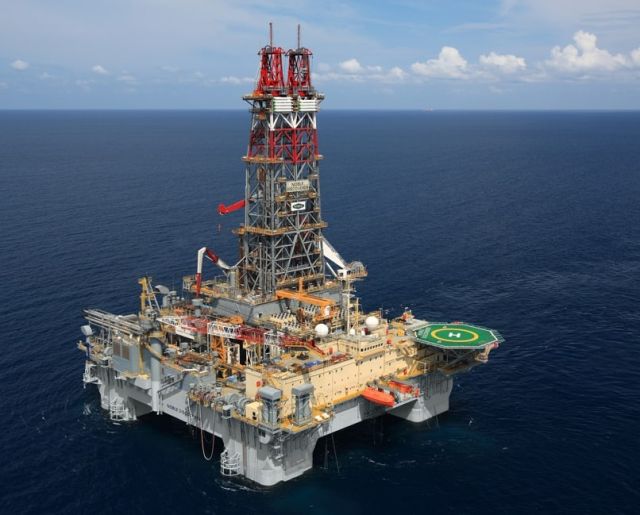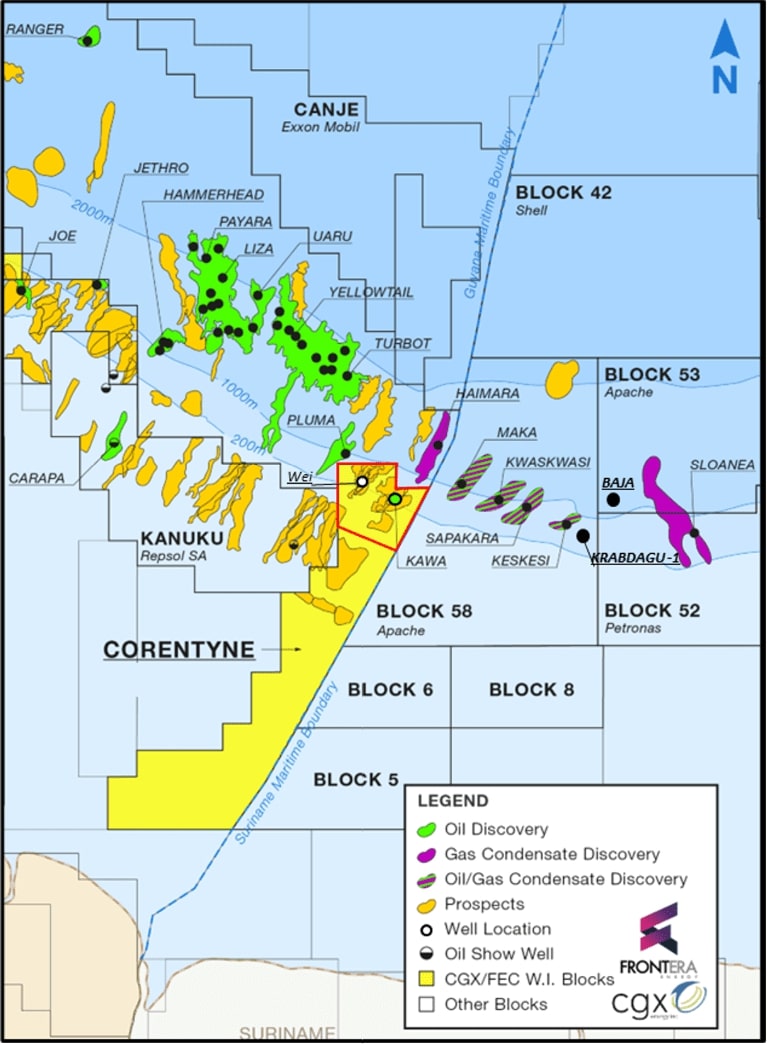
The Noble Discoverer semisubmersible drilled the Wei-1 well, which discovered 114 ft of net pay offshore Guyana. (Source: Noble Corp.)
CGX Energy Inc. and Frontera Energy Corp. discovered 114 ft of net pay with the Wei-1 well in the Corentyne Block offshore Guyana and awarded work for a subsea conceptual development plan, the companies announced Nov. 9.
So far, the block’s partners discovered 342 ft of net pay in the block with the Wei-1 and Kawa-1 wells in the Maastrichtian, Campanian, Santonian and Coniacian horizons.
“Results indicate that the rock quality in the Maastrichtian at Wei-1 is analogous to that reported in the Liza discovery on Stabroek Block, further demonstrating the potential for a standalone shallow oil resource development across the entire Corentyne block,” Frontera’s CEO Orlando Cabrales said in a press release. “In addition, the joint venture believes that, further potential upside exists in the Campanian, in which mobile light oil was proven in downhole analysis of samples, and the Santonian, which has log pay and remains a potential target for future developments. Additional appraisal activities will be required to further assess commerciality and as input to optimize subsurface and production system development planning.”
Professor Suresh Narine, executive co-chairman of CGX’s board of directors, said in a press release the partners are incorporating Wei-1’s delivered data into geologic and geophysical models to update the initial evaluation of Kawa, the potential of the Maastrichtian and the potential of the remaining undrilled prospects, including areas between the Wei-1 and Kawa-1 wells.
Gabriel de Alba, chairman of Frontera’s board, and co-chairman of CGX’s board, said in a press release that the partners are reviewing options for the block, including a potential farm down.
Wei-1 discovery well
The Noble Discoverer semisubmersible drilled the Wei-1 well in 1,912 ft water depth, 14 km northwest of the Kawa-1 well. The well was drilled to 20,450 ft total depth, targeting Maastrichtian, Campanian and Santonian-aged stacked sands within channel and fan complexes in the northern section of the Corentyne Block. The data acquisition program at the Wei-1 well included wireline logging, fluid samples and sidewall coring throughout the various intervals.
In the Maastrichtian, Wei-1’s test results confirm 13 ft of net pay in high-quality sandstone reservoir with rock quality consistent with that reported in the Liza discovery.
Fluid samples retrieved from the Maastrichtian and log analysis confirm the presence of sweet medium crude oil. In the Campanian, petrophysical analysis confirms 61 ft of net pay almost completely contained in one contiguous sand body with good porosity and moveable oil. Oil sampled confirmed the presence of light crude oil.
In the Santonian, petrophysical analysis confirms 40 ft of net pay in blocky sands with indications of oil in core samples. Interpretation of the Campanian and Santonian horizons show lower permeability than the high-quality Maastrichtian, but the partners believe the horizons may offer additional upside potential in the future.
Total costs associated for the Wei-1 well are estimated at $185 million to $190 million.
Conceptual development
Based on results from the Wei-1 and Kawa-1 wells, the partners have retained SIA, a Subsea 7 – SLB joint venture, to create a conceptual field development plan for the northern portion of the Corentyne Block, including subsea architecture, development well planning, production and export facilities and other considerations. The block partners believe that a potential development of the Maastrichtian horizon may have lower associated development costs and completed on a faster timeline than a broader development of both the shallow and deep zones on the entire Corentyne Block.
Frontera is a majority shareholder of CGX.

Recommended Reading
US Oil Rig Count Rises to Highest Since June
2025-04-04 - Baker Hughes said oil rigs rose by five to 489 this week, their highest since June, while gas rigs fell by seven, the most in a week since May 2023, to 96, their lowest since September.
Black Gold, LGX Find Multiple Pay Zones in Western Indiana
2025-04-04 - Black Gold Exploration Corp. and LGX Energy Corp. are working to start production at the Fritz 2-30 oil and gas well in Indiana within 60 days.
Pennsylvania City to Turn Coal-Powered Plant into Gas-Fired Data Center Campus
2025-04-03 - Construction on the Homer City Generating Station is expected to start in 2026.
BP’s Cypre Development Off Trinidad and Tobago Delivers First Gas
2025-04-03 - BP Trinidad and Tobago said the Cypre development is projected to deliver approximately 45,000 boe/d at peak.
Sitio Fights for its Place Atop the M&R Sector
2025-04-02 - The minerals and royalties space is primed for massive growth and consolidation with Sitio aiming for the front of the pack.
Comments
Add new comment
This conversation is moderated according to Hart Energy community rules. Please read the rules before joining the discussion. If you’re experiencing any technical problems, please contact our customer care team.




